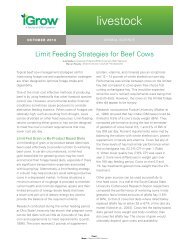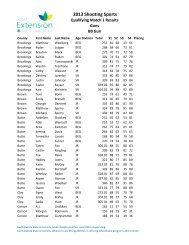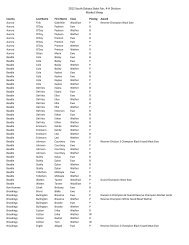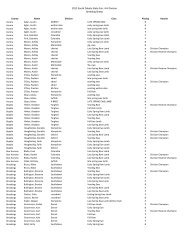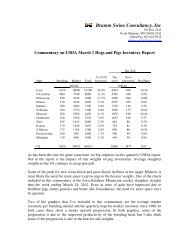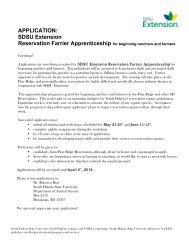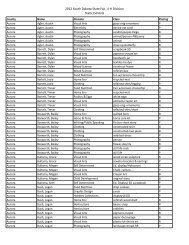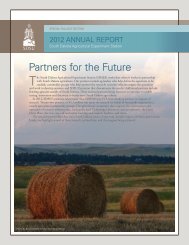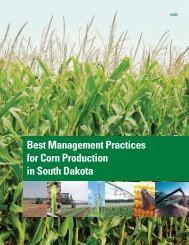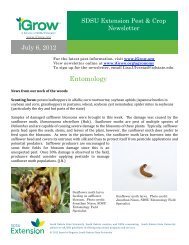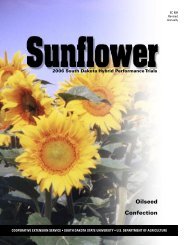Commitment to Collaboration - iGrow
Commitment to Collaboration - iGrow
Commitment to Collaboration - iGrow
Create successful ePaper yourself
Turn your PDF publications into a flip-book with our unique Google optimized e-Paper software.
<strong>Commitment</strong> <strong>to</strong> <strong>Collaboration</strong><br />
Working Together On Common Goals Adds Efficiency<br />
To Budgets; Effectiveness To Solutions<br />
Helen Keller is credited with the quote “Alone we can do so little; <strong>to</strong>gether we can do so much,” – and in <strong>to</strong>day’s world, that<br />
simple collaborative observation still rings true. Partnerships, teamwork and collaboration are now – more than ever –<br />
the essential building blocks for progress and success.<br />
Through its mission of teaching, research and Extension outreach, SDSU’s College of Agriculture and Biological<br />
Sciences faces a growing number of services <strong>to</strong> provide and challenges <strong>to</strong> address – while resources and finances continue <strong>to</strong> be<br />
limited. However, partnerships and collaboration with government entities, private industry and commodity organizations provide<br />
an opportunity throughout the state <strong>to</strong> leverage tax dollars and achieve effective solutions.<br />
Here, we highlight several examples of these efforts and SDSU’s continued commitment <strong>to</strong> collaboration.<br />
Tackling Mountain Pine Beetle and other tree needs<br />
As the Black Hills region struggles <strong>to</strong> s<strong>to</strong>p<br />
the deadly Mountain Pine Beetle – which<br />
is estimated <strong>to</strong> have killed 4 million<br />
Pondersoa pine in 2012, SDSU forestry<br />
professor and Extension specialist John Ball<br />
is in the thick of the battle. Ball also has a<br />
split appointment with the South Dakota<br />
Department of Ag’s Division of Forestry.<br />
Given his forestry experience and<br />
expertise, Ball is working closely with<br />
others in the state – including staff from<br />
the Black Hills National Forest – <strong>to</strong> tackle<br />
the Mountain Pine Beetle issue. Land<br />
surveys, research and landowner education<br />
are the current strategies being used in the<br />
collaborative approach <strong>to</strong> s<strong>to</strong>p the bug’s<br />
invasion.<br />
2 GROWING SOUTH DAKOTA WINTER 2013<br />
Ball’s role also has him teaching forestry<br />
courses on campus, conducting research,<br />
as well as providing landowner and logger<br />
education programs. He also enjoys oneon-one<br />
opportunities <strong>to</strong> help individual<br />
landowners in urban and rural settings<br />
learn more about caring for – and saving –<br />
their own trees. Next up on his docket<br />
is addressing management and control<br />
of the Emerald Ash Borer (EAB) that is<br />
expected <strong>to</strong> arrive in South Dakota from<br />
eastern states.<br />
For more information contact John.Ball@<br />
sdstate.edu or call (605) 688-4737.
Promoting the next generation of lives<strong>to</strong>ck production<br />
Agriculture generates billions of dollars<br />
for South Dakota’s economy – and<br />
employs approximately 123,000 people<br />
in ag-related jobs across the state. With<br />
the global population growing rapidly,<br />
the need for food is also increasing and<br />
expected <strong>to</strong> double by 2050.<br />
And, South Dakota has an<br />
opportunity <strong>to</strong> lead in supplying safe,<br />
wholesome ag commodities for the<br />
world’s future food needs.<br />
Lynn Gordon, a SDSU Beef Extension<br />
Field Specialist, points out, “South<br />
Dakota is fortunate <strong>to</strong> have access <strong>to</strong><br />
land for producing food and <strong>to</strong> water<br />
for raising crops for feed resources –<br />
along with the people and infrastructure<br />
necessary <strong>to</strong> be domestic and international<br />
leaders in production agriculture.”<br />
To that end, SDSU Extension and the<br />
South Dakota Department of Agriculture<br />
(SDDA) have joined <strong>to</strong>gether <strong>to</strong> spotlight<br />
the opportunities available in the state<br />
for lives<strong>to</strong>ck development and the ripple<br />
effect that a strong agricultural economy<br />
has throughout the state.<br />
A series of meetings will be held across<br />
South Dakota from January through<br />
Dual appointment benefits health of South Dakota’s people, lives<strong>to</strong>ck<br />
As an Extension Veterinarian and<br />
Associate Professor at SDSU, Russ Daly<br />
has primarily focused on lives<strong>to</strong>ck health<br />
and disease in his service <strong>to</strong> the state.<br />
But in 2011, he was appointed as the<br />
State Public Health Veterinarian with the<br />
South Dakota Department of Health as<br />
well – meaning he also keeps a watchful<br />
eye on human health and zoonotic<br />
diseases which can pass from animals <strong>to</strong><br />
humans and vice versa.<br />
Daly explains that most state health<br />
departments have their own dedicated<br />
public health veterinarian, so in South<br />
Dakota this dual role with University<br />
Extension and the state Health<br />
Department is unique.<br />
Daly does not draw a salary from the<br />
state Health Department, but he says<br />
the partnership allows both the agency<br />
www.sdstate.edu/abs<br />
March at area lives<strong>to</strong>ck auction markets <strong>to</strong><br />
help lives<strong>to</strong>ck producers and communities<br />
recognize the benefits of growing South<br />
Dakota’s lives<strong>to</strong>ck industry for the future.<br />
“Whether it is beef cattle, dairy cattle<br />
or pork production, a thriving lives<strong>to</strong>ck<br />
industry means thriving communities<br />
and counties and a strong infrastructure,”<br />
says Sarah Caslin, Lives<strong>to</strong>ck Development<br />
Coordina<strong>to</strong>r for the SDDA. She points<br />
out that the agricultural sec<strong>to</strong>r is the<br />
and the University <strong>to</strong> collaborate and<br />
achieve their goals – particularly with<br />
regard <strong>to</strong> educational messages related <strong>to</strong><br />
animal contact and/or disease risk <strong>to</strong> the<br />
public. He notes, “It allows the health<br />
department access <strong>to</strong> the educational and<br />
outreach capabilities of SDSU Extension<br />
in a very unique and effective way.”<br />
Additionally, Daly’s relationship<br />
with the SD Department of Health<br />
has already resulted in enhanced<br />
research collaboration. As examples, a<br />
twice-yearly discussion group has been<br />
formed bringing many state agencies<br />
and stakeholders <strong>to</strong>gether <strong>to</strong> discuss<br />
zoonotic disease issues important <strong>to</strong><br />
South Dakota. As well, Daly was able<br />
<strong>to</strong> secure a grant this summer which<br />
allowed him <strong>to</strong> study human cases of<br />
E.coli and Cryp<strong>to</strong>spiridum infection <strong>to</strong><br />
COMMITMENT TO COLLABORATION<br />
largest single sec<strong>to</strong>r of South Dakota’s<br />
economy, and each dollar of agricultural<br />
output generates economic activity for the<br />
state, which also makes it more profitable<br />
and feasible for the next generation <strong>to</strong><br />
return <strong>to</strong> the farm.<br />
Announcements of upcoming meeting<br />
dates are available on <strong>iGrow</strong>.org. For more<br />
information contact Sarah Caslin, SDDA,<br />
(605) 280-4833 or Lynn Gordon, SDSU,<br />
(605) 782-3290.<br />
identify whether exposure <strong>to</strong> animals may<br />
have increased the risk for exposure. He<br />
says, “Working with the South Dakota<br />
Department of Health has allowed access<br />
<strong>to</strong> medical case information for research<br />
that has not normally been available <strong>to</strong><br />
Extension.”<br />
Daly was recently appointed as SDSU’s<br />
Interim Department Head of Veterinary<br />
and Biomedical Sciences. Edi<strong>to</strong>r’s Note:<br />
During 2012, Daly reports that strong<br />
collaboration also occurred among SDSU<br />
Extension, veterinarians at SDSU’s Animal<br />
Disease Research & Diagnostic Labora<strong>to</strong>ry<br />
and the South Dakota Game Fish & Parks<br />
as they addressed concerns and control of<br />
Epizootic Hemorrhagic Disease (EHD) in<br />
South Dakota deer and cattle populations.<br />
WINTER 2013 GROWING SOUTH DAKOTA 3
COMMITMENT TO COLLABORATION<br />
Serving rural<br />
communities;<br />
Strengthening rural<br />
economies<br />
Building leadership skills. Promoting<br />
small business and the rural economy.<br />
Developing food entrepreneurship<br />
networks. These are a sample of the <strong>to</strong>pics<br />
and projects being addressed as SDSU<br />
Extension’s community development<br />
team works with communities across<br />
South Dakota.<br />
Presently, SDSU Extension<br />
is partnering with USDA Rural<br />
Development on a unique grant called<br />
“Stronger Economies Together.” Two<br />
regions in the state were chosen <strong>to</strong><br />
participate in the 2-year program which<br />
is designed <strong>to</strong> assist them in forming<br />
a regional group <strong>to</strong> write a regional<br />
economic development plan. The<br />
counties of Kingsbury, Jerauld, Beadle,<br />
Spink, Clark and Hand will form one<br />
regional group, while West River counties<br />
Haakon, Jackson and eastern Penning<strong>to</strong>n<br />
will form the second group.<br />
Another USDA Rural Development<br />
grant was recently received by SDSU<br />
Extension <strong>to</strong> build South Dakota’s local<br />
food system through the establishment of<br />
an online Local Foods Center. The aim is<br />
<strong>to</strong> create structured connections between<br />
local growers and resource providers. The<br />
online center will allow resource providers<br />
across the state <strong>to</strong> supply a collection of<br />
4 GROWING SOUTH DAKOTA WINTER 2013<br />
educational materials such as podcasts,<br />
fact sheets and guides related <strong>to</strong> local<br />
food entrepreneurship, processing and<br />
production.<br />
Additionally, SDSU Extension<br />
community development specialists have<br />
hosted numerous programs across the<br />
state. A “Small Business Beginnings”<br />
series of classes was held in Newell in<br />
Oc<strong>to</strong>ber and November <strong>to</strong> help new and<br />
expanding business owners. A similar<br />
series of classes with an emphasis on<br />
food entrepreneurship was held over the<br />
summer and fall in Montrose, Estelline<br />
and Kadoka/Philip.<br />
This fall, the communities of Hot<br />
Springs and Mitchell hosted one-day<br />
workshops with the theme “Growing<br />
Leaders SD.” SDSU Extension worked<br />
with local chambers of commerce and<br />
young professionals groups <strong>to</strong> coordinate<br />
these workshops and focus on developing<br />
leadership skills among aspiring leaders in<br />
communities.<br />
Staff is also coaching youth /adult<br />
groups in four high schools on a project<br />
called, “Youth Voices.” The communities<br />
of Philip, Eureka, Kimball, and Hyde<br />
Co. have put <strong>to</strong>gether a committed group<br />
of 6-8 youth and 6-8 adults planning<br />
projects <strong>to</strong> improve the quality of life in<br />
their <strong>to</strong>wns.<br />
Of these efforts across the state, SDSU<br />
Extension Field Specialist Kari O’Neill<br />
says, “SDSU Extension recognizes the<br />
value of our rural communities and<br />
the leaders who live there. All of our<br />
community development programs<br />
are focused on building capacity in<br />
communities so that as residents plan for<br />
the future, new leaders will step up <strong>to</strong> the<br />
plate with the knowledge of how <strong>to</strong> put<br />
those plans in<strong>to</strong> action.”<br />
For more about SDSU Extension’s<br />
community development programs<br />
contact David.Olson@sdstate.edu or<br />
call (605) 688-5614.<br />
Invigorating South Dakota’s sheep industry<br />
A new effort is underway <strong>to</strong> help potential<br />
and beginning sheep producers enter and<br />
expand in<strong>to</strong> the sheep industry in the<br />
state. Sixteen beginning farmer/rancher<br />
sheep operations from across South<br />
Dakota have committed <strong>to</strong> the three-year<br />
long program called sheepSD.<br />
As members of sheepSD, these sheep<br />
producers will become part of a learning<br />
community that will prioritize the<br />
industry relevant <strong>to</strong>pics of study as well as<br />
apply for grants and funding <strong>to</strong> improve<br />
the learning experience. The program<br />
will also provide men<strong>to</strong>rship by current<br />
successful sheep ranchers <strong>to</strong> beginning<br />
sheep producers.<br />
The three-year program is being<br />
administered by SDSU Extension in<br />
collaboration and with co-funding from<br />
the American Sheep Industry.<br />
To learn more about sheepSD, contact<br />
David.Ollila@sdstate.edu or call (605)<br />
394-1722. A similar program called beefSD<br />
is available for the state’s beginning beef<br />
producers. To enroll contact Ken.Olson@<br />
sdstate.edu or call (605) 394-2236.
Initiative addresses South Dakota’s food deserts<br />
All of South Dakota’s Indian Reservations<br />
are classified as “food deserts” – areas in<br />
which residents have limited access <strong>to</strong> large<br />
food retailers, and particularly fresh foods.<br />
In response <strong>to</strong> this, SDSU Extension has<br />
placed an emphasis on providing training<br />
<strong>to</strong> tribal communities for home gardening,<br />
youth gardens, and ultimately establishing<br />
commercial growers who may also tap in<strong>to</strong><br />
entrepreneurship opportunities.<br />
Shawn Burke, the Native American<br />
Program Direc<strong>to</strong>r for SDSU Extension,<br />
reports that numerous partners have<br />
teamed with Extension <strong>to</strong> help grow this<br />
effort. Partners across the state include<br />
tribal governments; Lakota Funds and<br />
Hunkpati Investments, Inc. which are<br />
both community development financial<br />
institutions; the Club for Boys in Rapid<br />
City and many more.<br />
Extension programs on healthy foods<br />
have reached all of the reservations<br />
www.sdstate.edu/abs<br />
in the state in some form in 2012 –<br />
from workshops on gardening <strong>to</strong> food<br />
processing and food preservation.<br />
One example project involved a<br />
youth garden program at the Club for<br />
Boys in Rapid City. SDSU Extension<br />
provided funding for development of 19<br />
garden plots during the summer of 2012.<br />
Students from Central High School helped<br />
build some of the gardens. As well, Master<br />
Gardeners, Extension staff and employees<br />
from local restaurants were involved with<br />
the growing, harvest and educational<br />
exchange involved with the project.<br />
On the Crow Creek Sioux Indian<br />
Reservation, SDSU Extension has also<br />
worked with the Crow Creek Fresh Food<br />
Initiative administered by Hunkpati<br />
Investments, and funded by First Nations<br />
Development Fund. This summer the<br />
commercial garden project expanded from<br />
a few raised beds <strong>to</strong> a half acre garden as<br />
Teaming up <strong>to</strong> strengthen farm business management<br />
The old adage “two heads are better than<br />
one” is evident with a partnership that<br />
has been forged over the past year in<br />
Mitchell, SD. When reorganization of<br />
SDSU Extension occurred in Oc<strong>to</strong>ber<br />
2011, the Regional Extension Center in<br />
Mitchell was housed under the same roof<br />
as Mitchell Technical Institute.<br />
Both entities serve farmers and<br />
ranchers, so it’s no surprise that<br />
collaboration <strong>to</strong>ok root. Mitchell<br />
Technical Institute had recently<br />
established a Center for Farm/Ranch<br />
Management with the aim of helping<br />
South Dakota agricultural producers<br />
become better business managers. SDSU<br />
Extension has a long his<strong>to</strong>ry of providing<br />
technical assistance <strong>to</strong> agricultural<br />
producers on everything from economics<br />
<strong>to</strong> lives<strong>to</strong>ck nutrition, breeding and<br />
genetics, range management and more.<br />
By working <strong>to</strong>gether both MTI and<br />
SDSU Extension have been better able <strong>to</strong><br />
serve South Dakota producers, believes<br />
Jack Davis, an Economics Field Specialist<br />
at the Mitchell Regional Extension<br />
COMMITMENT TO COLLABORATION<br />
it works <strong>to</strong>ward its goals <strong>to</strong> grow enough<br />
fresh fruits and vegetables <strong>to</strong> provide for<br />
the community; encourage agricultural<br />
entrepreneurship; educate tribal members<br />
about the newly available fruits and<br />
vegetables; and teach children about<br />
nutrition and agriculture.<br />
Whitney Jandreau provided oversight of<br />
the Crow Creek Fresh Food Initiative for<br />
the 2012 growing season and says, “SDSU<br />
Extension has been a great resource in the<br />
growth of our program. My dream is <strong>to</strong><br />
see the Crow Creek Fresh Food Initiative<br />
become its own non-profit organization<br />
in the future, and I believe the knowledge<br />
shared by SDSU Extension will play a<br />
crucial role in making that happen.”<br />
For more information about the Healthy<br />
Foods and Garden Initiative contact Shawn.<br />
Burke@sdstate.edu or call (605)394-2236.<br />
Center. “It’s been a great opportunity<br />
<strong>to</strong> provide farm and ranch management<br />
information – from economics <strong>to</strong><br />
operational – <strong>to</strong> the people of South<br />
Dakota,” Davis says.<br />
In the past year, the two entities<br />
have worked with one another <strong>to</strong> offer<br />
several educational seminars including<br />
the Ag CEO program; a program titled<br />
Beef Cattle Marketing: An Explorative<br />
Approach; and most recently, the Beef<br />
Production Audit series, which includes<br />
six sessions focusing a various segments of<br />
the beef production system. To highlight<br />
their farm business program efforts,<br />
SDSU Extension and MTI also shared a<br />
booth space during the annual Dakotafest<br />
in Mitchell in August.<br />
Of the future Davis says, “There are<br />
many educational opportunities <strong>to</strong> work<br />
<strong>to</strong>gether, and our partnership with MTI<br />
has great potential.”<br />
For more information about the farm<br />
business management programs offered<br />
contact Jack.Davis@sdstate.edu or call<br />
(605) 995-7385.<br />
WINTER 2013 GROWING SOUTH DAKOTA 5
COMMITMENT TO COLLABORATION<br />
Working <strong>to</strong>gether <strong>to</strong> address obesity; Offer healthy concession choices<br />
In an effort <strong>to</strong> address obesity –<br />
particularly among kids – SDSU<br />
Extension and the South Dakota<br />
Department of Health are collaborating<br />
<strong>to</strong> implement “Munch Code,” a program<br />
for concession stands. The program,<br />
developed by the Department of Health,<br />
promotes healthy concession choices by<br />
identifying food and beverage items with<br />
green, yellow and red color codes. Green<br />
foods and beverages are the healthiest<br />
options and can be enjoyed often; because<br />
of the levels of added sugar, fat and<br />
calories, yellow items should be eaten<br />
occasionally and red items sparingly.<br />
State grant funding from the<br />
Department of Health has allowed for an<br />
SDSU Extension position <strong>to</strong> be dedicated<br />
<strong>to</strong> the implementation and development<br />
of this program across the state. Megan<br />
Sex<strong>to</strong>n, an SDSU Extension Nutrition<br />
6 GROWING SOUTH DAKOTA WINTER 2013<br />
Field Specialist in the Sioux Falls Regional<br />
Extension Center currently fulfills that<br />
role. Recently, additional funds from the<br />
Department of Education have helped <strong>to</strong><br />
implement the program.<br />
Sex<strong>to</strong>n has worked <strong>to</strong> create awareness<br />
and educate others about the optional<br />
program, and says the response has been<br />
overwhelmingly positive. She explains<br />
that Munch Code simply means offering<br />
more fruit, vegetable, yogurt and skim<br />
milk options within the concession stand,<br />
and also making easy substitutions such<br />
as offering a lower fat turkey hot dog or a<br />
veggie pizza with a whole grain crust.<br />
Sex<strong>to</strong>n explains that two years ago<br />
the Munch Code program was piloted<br />
<strong>to</strong> target non-school related concession<br />
events such as hockey and baseball, as<br />
well as park and recreation facilities like<br />
Providing resources for crops, environment<br />
Throughout South Dakota, SDSU<br />
researchers and Extension specialists<br />
are at work <strong>to</strong> aid in the continued<br />
improvement of crops and conservation<br />
efforts. As one example, Chris Hay, SDSU<br />
Extension water management engineer,<br />
(pictured above at right) helped lead a<br />
field demonstration project this summer<br />
near Baltic, SD, that implemented a<br />
bioreac<strong>to</strong>r as part of a drainage system.<br />
The bioreac<strong>to</strong>r is designed <strong>to</strong> reduce losses<br />
of nitrates <strong>to</strong> surface water.<br />
The project was showcased as part of<br />
the AgPhD Field Day in late July hosted<br />
by Hefty Seed Company with more than<br />
4,000 attendees.<br />
The demonstration project was<br />
made possible with funding from a<br />
Conservation Innovation Grant from the<br />
Natural Resources Conservation Service<br />
(NRCS), with additional funding support<br />
from the East Dakota and Vermillion<br />
Water Development Districts, SD Corn,<br />
SD Farm Bureau, and SD Soybean.<br />
Advanced Drainage Systems, Agri Drain<br />
Corporation, Hefty Seed Company and<br />
SDSU provided in-kind support.<br />
This winter SDSU researchers are<br />
installing a second bioreac<strong>to</strong>r study site,<br />
with two more planned for next spring.<br />
Learn more about the research at www.<br />
sdstate.edu/abe/wri/research-projects/<br />
bioreac<strong>to</strong>rs.cfm.<br />
swimming pools. Now, it has expanded <strong>to</strong><br />
include concessions at schools.<br />
Kristin Biskeborn with the South<br />
Dakota Department of Health notes<br />
that they’ve had a long standing working<br />
relationship with SDSU Extension over<br />
the years, but is pleased that a dedicated<br />
staff person is making Munch Code<br />
successful – and is making it easier for<br />
kids and adults <strong>to</strong> eat healthy.<br />
Learn more at www.munchcode.org.<br />
Additional resources offered by SDSU<br />
Extension include:<br />
Continuing <strong>to</strong> offering the Pesticide<br />
Applica<strong>to</strong>r Training program for<br />
commercial and private applica<strong>to</strong>rs.<br />
Extension provides the educational<br />
portion of the program, while the<br />
South Dakota Department of Ag<br />
oversees funding and regula<strong>to</strong>ry issues.<br />
For 2013, some of the training may be<br />
offered in a “smart class” format where<br />
applica<strong>to</strong>rs gather for the training at<br />
a meeting location and instruc<strong>to</strong>rs are<br />
featured online.<br />
Developing a 2-minute animated<br />
video showing how <strong>to</strong> properly speedscout<br />
for soybean aphids. SDSU<br />
en<strong>to</strong>mologist Buyung Hadi worked<br />
with SDSU professor of animation<br />
and film Cable Hardin and SDSU<br />
Extension soybean en<strong>to</strong>mologist Kelley<br />
Tilmon <strong>to</strong> produce the video. The<br />
collaboration recently earned an award<br />
from the En<strong>to</strong>mological Society of<br />
America and was also written about in<br />
the New York Times.View it on YouTube<br />
at: http://www.youtube.com/watch?v=n_<br />
WmCQA0OHs



